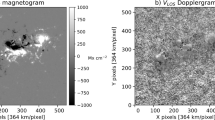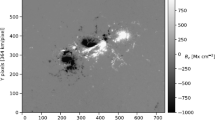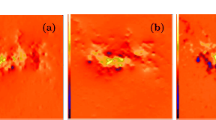Abstract
The availability of vector-magnetogram sequences with sufficient accuracy and cadence to estimate the temporal derivative of the magnetic field allows us to use Faraday’s law to find an approximate solution for the electric field in the photosphere, using a Poloidal–Toroidal Decomposition (PTD) of the magnetic field and its partial time derivative. Without additional information, however, the electric field found from this technique is under-determined – Faraday’s law provides no information about the electric field that can be derived from the gradient of a scalar potential. Here, we show how additional information in the form of line-of-sight Doppler-flow measurements, and motions transverse to the line-of-sight determined with ad-hoc methods such as local correlation tracking, can be combined with the PTD solutions to provide much more accurate solutions for the solar electric field, and therefore the Poynting flux of electromagnetic energy in the solar photosphere. Reliable, accurate maps of the Poynting flux are essential for quantitative studies of the buildup of magnetic energy before flares and coronal mass ejections.
Similar content being viewed by others
References
Chae, J., Sakurai, T.: 2008, A test of three optical flow techniques – LCT, DAVE, and NAVE. Astrophys. J. 689, 593 – 612. doi: 10.1086/592761 .
Fisher, G.H., Welsch, B.T.: 2008, FLCT: A fast, efficient method for performing local correlation tracking. In: Howe, R., Komm, R.W., Balasubramaniam, K.S., Petrie, G.J.D. (eds.) Subsurface and Atmospheric Influences on Solar Activity CS-383, Astron. Soc. Pac., San Francisco, 373 – 380 (also arXiv:0712.4289 ).
Fisher, G.H., Welsch, B.T., Abbett, W.P., Bercik, D.J.: 2010, Estimating electric fields from vector magnetogram sequences. Astrophys. J. 715, 242 – 259. doi: 10.1088/0004-637X/715/1/242 .
Hurlburt, N.E., Schrijver, C.J., Shine, R.A., Title, A.M.: 1995, Simulated MDI observations of convection. In: Hoeksema, J.T., Domingo, V., Fleck, B., Battrick, B. (eds.) Helioseismology SP-376, ESA, Noordwijk, 239.
Kusano, K., Maeshiro, T., Yokoyama, T., Sakurai, T.: 2002, Measurement of magnetic helicity injection and free energy loading into the solar corona. Astrophys. J. 577, 501 – 512.
Longcope, D.W.: 2004, Inferring a photospheric velocity field from a sequence of vector magnetograms: the minimum energy fit. Astrophys. J. 612, 1181 – 1192.
November, L.J., Simon, G.W.: 1988, Precise proper-motion measurement of solar granulation. Astrophys. J. 333, 427 – 442.
Potts, H.E., Barrett, R.K., Diver, D.A.: 2004, Balltracking: An highly efficient method for tracking flow fields. Astron. Astrophys. 424, 253 – 262. doi: 10.1051/0004-6361:20035891 .
Ravindra, B., Longcope, D.W., Abbett, W.P.: 2008, Inferring photospheric velocity fields using a combination of minimum energy fit, local correlation tracking, and Doppler velocity. Astrophys. J. 677, 751 – 768. doi: 10.1086/528363 .
Scherrer, P.H., The HMI Team: 2005, The helioseismic and magnetic imager for the solar dynamics observatory. In: AGU Spring Meeting Abstracts, 43-05.
Schuck, P.W.: 2006, Tracking magnetic footpoints with the magnetic induction equation. Astrophys. J. 646, 1358 – 1391. doi: 10.1086/505015 .
Schuck, P.W.: 2008, Tracking vector magnetograms with the magnetic induction equation. Astrophys. J. 683, 1134 – 1152. doi: 10.1086/589434 .
Schuck, P.W., Sun, X., Muglach, K., Hoeksema, J.T.: 2010, Tracking vector magnetograms from the solar dynamics observatory. In: AGU Fall Meeting Abstracts, A7.
Title, A.M., Hurlburt, N.E., Schrijver, C.J., Shine, R.A., Tarbell, T.: 1995, Observations of convection. In: Hoeksema, J.T., Domingo, V., Fleck, B., Battrick, B. (eds.) Helioseismology SP-376, ESA, Noordwijk, 113.
Welsch, B.T.: 2006, Magnetic flux cancellation and coronal magnetic energy. Astrophys. J. 638, 1101 – 1109. doi: 10.1086/498638 .
Welsch, B.T., Fisher, G.H., Abbett, W.P., Regnier, S.: 2004, ILCT: Recovering photospheric velocities from magnetograms by combining the induction equation with local correlation tracking. Astrophys. J. 610, 1148 – 1156. doi: 10.1086/421767 .
Welsch, B.T., Abbett, W.P., DeRosa, M.L., Fisher, G.H., Georgoulis, K., Kusano, M.K., Longcope, D.W., Ravindra, B., Schuck, P.W.: 2007, Tests and comparisons of velocity inversion techniques. Astrophys. J. 670, 1434 – 1452.
Author information
Authors and Affiliations
Corresponding author
Additional information
Solar Flare Magnetic Fields and Plasmas
Guest Editors: Y. Fan and G.H. Fisher
Rights and permissions
About this article
Cite this article
Fisher, G.H., Welsch, B.T. & Abbett, W.P. Can We Determine Electric Fields and Poynting Fluxes from Vector Magnetograms and Doppler Measurements?. Sol Phys 277, 153–163 (2012). https://doi.org/10.1007/s11207-011-9816-4
Received:
Accepted:
Published:
Issue Date:
DOI: https://doi.org/10.1007/s11207-011-9816-4




